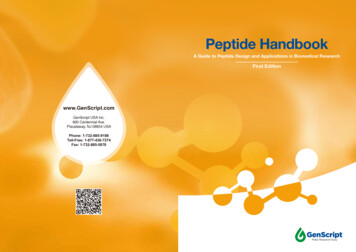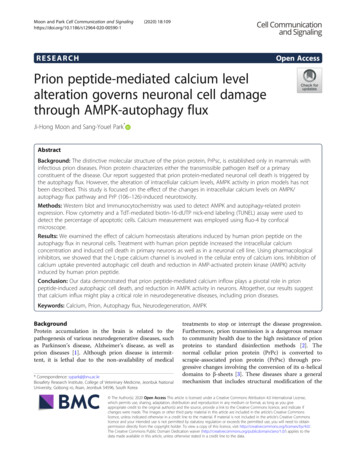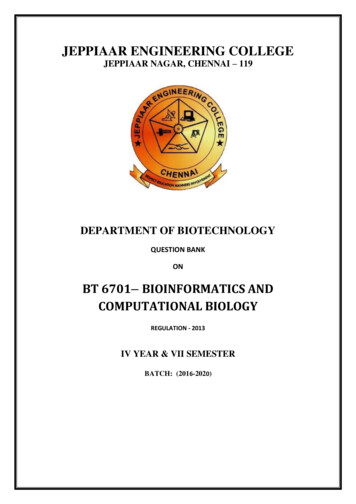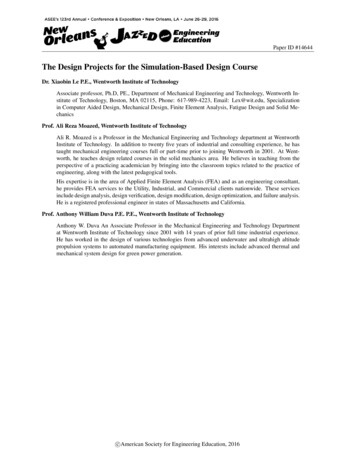
Transcription
Peptide HandbookA Guide to Peptide Design and Applications in Biomedical ResearchFirst Editionwww.GenScript.comGenScript USA Inc.860 Centennial Ave.Piscataway, NJ 08854 USAPhone: 1-732-885-9188Toll-Free: 1-877-436-7274Fax: 1-732-885-5878
Table of ContentsReliable Synthesis of High-Quality Peptidesby GenScriptFlexPeptideTM Peptide Synthesis Platform which takes advantage of the latestpeptide synthesis technologies generates a large capacity for the quicksynthesis of high-quality peptides in a variety of lengths, quantities, puritiesand modifications.Total Quality Management System based on multiple rounds of MS and HPLCanalyses during and after peptide synthesis ensures the synthesis ofhigh-quality peptides free of contaminants, and provides reports on peptidesolubility, quality and content.Diverse Delivery Options help customers plan their peptide-based researchaccording to their time schedule and with peace of mind.ArgonShield Packing eliminates the experimental variation caused byoxidization and deliquescence of custom peptides through an innovativepacking and delivery technology.Expert Support offered by Ph.D.-level scientists guides customers frompeptide design and synthesis to reconstitution and k.htmlThe Universe of PeptidesMolecular structureCharacteristicsCategories and biological functionsAnalytical methods35810Application of PeptidesResearch in structural biologyResearch in disease pathogenesisGenerating antibodiesVaccine developmentDrug discovery and developmentImmunotherapyCell penetration-based applicationsAnti-microorganisms applicationsTissue engineering and regenerative medicineCosmeticsFood industry1212131415171819202121Synthesis of PeptidesChemical synthesisMicrowave-assisted technologyLigation technologyRecombinant technologyModificationsPurificationProduct identity and quality controlReconstitution, storage and handlingDelivery formatsConsiderations in peptide design23242628283031323435Future of Peptides38Resources on PeptidesPeptide-related toolsTroubleshooting guideReferences4041441
Molecular StructureChapter OneThe Universe of PeptidesThe word peptide, derived from the Greek word “peptós/digested,” refers to a chain ofamino acids (AAs) linked together via amide or peptide bonds. The formation of thecovalent peptide bond is an example of a condensation reaction, which generateswater from the combination of the α-carboxyl group of one AA and the α-amino groupof another. An AA unit within a peptide chain is called a "residue”. A peptide can be asshort as two residues with only one peptide bond (named “dipeptide”) or as long asseveral residues forming a continuous and unbranched peptide chain (named “oligopeptide” if containing 20 AAs or polypeptide if containing 20 AAs). Proteins arecomprised of many peptide chains and sometimes the terms “polypeptide” and“protein” are used interchangeably. There are several different conventions formaking a distinction between the two, but in general, molecules referred to aspolypeptides have molecular weights (MWs) below 10,000 Daltons or less than 50AAs, and molecules above these limits are considered as proteins (Lehninger et al.)Peptide Bond FormationAmino Acid 1HRNHHOOAmino Acid 2HHRNHHORNHHOHWaterDipeptideHOH H ONROHOHHPeptide Bond3
In a peptide chain, the AA at the end with a free α-amino group is called the “amino-terminal” (N-terminal) residue, whereas the one at the other end with a free carboxyl groupis called the “carboxyl-terminal” (C-terminal) residue. The backbone carbon before thecarboxyl carbon in an AA is called the “alpha carbon” (Cα) or “chiral center”, where different side chains attach. Depending on the position of carbon atoms relative to Cα, theremaining carbons are named with Greek letters of β, γ, etc.Numbering Carbon Atoms in an AAεδ5CH26CH2 NHγ4CH2β3CH2α2CH NH31COO-3Due to the possibility of forming two different enantiomers (stereoisomers) aroundthe central carbon atom, all AAs except Glycine can exist in two isomeric configurationsof D (dextrorotatory; right-handed) and L (levorotatory; left-handed). Until recently,most AAs synthesized by eukaryotes were reported to be in the L-isoform, whereasD-isoforms were predominantly found in bacterial cell wall proteins or synthesizedchemically. However, due to latest developments in sensitive analytical methods, freeD-amino acids are shown to be present in the nervous system and venom of animals aswell (Kiriyama & Nochi).CharacteristicsEach peptide has its own unique structural and biochemical characteristics, such as anisoelectric pH (pI) and ionization behavior. These features are derived from the peptide’sAA components. Therefore, the overall characteristics of a peptide can change dependingon the quantity and type of each AA within the chain.For example, the acid-base behavior of a peptide is defined by the nature of the freeand bound AAs in its chain. The terminal α-amino and α-carboxyl groups sitting at oppositeends of the chain as well as the side chains (R groups) of some AAs can ionize and affect thetitration curve. Similarly, due to the positioning of the chiral carbon and stereoisomerconfigurations in all AAs except Glycine, the newly formed L or D isomer of AAs can add totheir unique characteristics. Ultimately all these characteristics influence how a givenpeptide behaves in a biological system.Formation of Acid or Base from an Amino AcidRONH2Amino Acid ChiralityOHH RONH3 OHPositive IonIn acidic conditions: acting like a O-H2ONegative IonIn basic conditions: acting like an acid.45
Common Amino AcidsSecondary Structure of PeptidesONH2OOHH2NAlanineMW: 89.09IP: 6.00ANH2TryptophanMW: 204.23IP: 5.89OCysteineMW: 121.16IP: 5.02NHOH ONH2ThreonineMW: 119.12IP: 5.64H 2NTONH2Aspartic AcidDMW: 133.1IP: 2.77QNH2ArginineMW: 174.2IP: 11.15OOHOHONHOHOOGlutamineMW: 146.15IP: 5.65COHWNH2HOOHRNH2OHGlutamic Acid EMW: 147.13IP: 3.2266OHONH2HONH2NH2NHistidineHMW: 155.16IP: 7.47NHOOHNCOProlinePMW: 115.13IP: 6.30CONCCONH2CHNOCNCCOHCHNCC NOCHCOβ-sheetOH2NCCHCHOHOHCC NOC NCHNCSerineSMW: 105.09IP: 5.68NCα-helixOHLysineKMW: 146.19IP: 9.59H 2NOHOHOOHCHNCOOHMethionine MMW: 149.21IP: 5.74HNNCAsparagineNMW: 132.12IP: 5.41OSNH 2HHOH2NTyrosineYMW: 181.19IP: 5.66OAliphatic amino acids with hydrophobic side chainAromatic amino acids with hydrophobic side ChainAmino acids with neutral side chainMW: Molecular WeightNH2HOOHOH2NOHNH2IOHValineVMW: 117.15IP: 5.96OOHONH2LeucineLMW: 131.17IP: 5.98HNPhenylalanineFMW: 165.19IP: 5.48HSOOOHNH2IsoleucineMW: 131.17IP: 5.94ONH2HOHGenScript’s Peptide Calculator can help you determine the chemicalformula and MW of your peptide of interest.OOHGlycineMW: 75.07IP: 5.97GAmino acids with positive charged side chainAmino acids with negative charged side chainUnique amino acidsIP: Isoelectric Point7
Categories and Biological FunctionsThe 7,000 naturally-occurring peptides are present in all organisms and have extensiveroles in the physiology of microorganisms, plants, animals, and humans. To better studyand use peptides, they can be classified using different methods. The function of peptidesas hormones, growth factors, ion channel ligands, neurotransmitters, and immune systemcomponents in biological systems is the basis of one method of peptide classification.Another approach is based on the way natural peptides are produced. Each method ofclassification may overlap with another and can be field or application specific.The intrinsic characteristics of natural peptides, such as instability and proteolytic degradation limit their medicinal application. To overcome this limitation peptide analogues or“peptidomimetics” have been developed to mimic the biological actions of peptideswithout undesired restrictions (Olson). Peptidomimetics are synthesized by modificationof an existing natural peptide or through introducing novel structural changes that renderresistance to proteolytic degradation, increase thermodynamic stability and provide thecapability to pass through the plasma membrane.Peptide vs PeptidomimeticsHOHNNHnRMajor Classes of PeptidesR'OHHOPeptideClassSourcemRNA osomal PeptidesRNAntibiotics, Hormones,Signaling peptides, BacteriocinsOONRNR'OHnβ-PeptoidNon-Ribosomal PeptidesPeptonesNon-ribosomal peptidesynthetasesEnzymatic digestion oracid hydrolysis of naturalproductsToxins, Cytostatics, Siderophores, Pigments, Antibiotics,ImmunosuppressantsHIngredient in bacteria andfungal growth mediaRNRR'ONHnβ3-PeptoidEnzymatic degradation oflaboratory samplesPeptide FragmentsDegradation of forensic orpaleontological samplesby natural effects8Identification or quantificationof the source proteinOOHHOHNRR'NHnOOHβ2-PeptoidAdapted from Olson, 2010.9
Analytical MethodsProper synthesis, characterization, and application of peptides require appropriateanalytical methods. A variety of methods are used in isolating, purifying, detecting,and quantifying all types of peptides. However, a few are more specific to the natureof a peptide and downstream applications. Furthermore, some methods aremulti-functional in that they can be used for two or more analytical purposes. In recenttimes, many of these methods have been coupled with fluorescence capabilities forimproved data collection and analysis.Methods for Peptide AnalysisIsolation/PurificationColumn yIon exchangeNMRSize exclusionCircular Dichroism (CD)chromatographyUV AbsorbanceQuantificationEnzymatic ActivityChapter TwoApplication of PeptidesBinding AssayAffinity chromatographyHigh-performance liquidchromatography(HPLC)Edman DegradationFunctional AssayPull-downTitration CurveMass Spectrometry (MS)Tandem MSAmino AcidAnalysis (AAA)Antibody-Based Detection1011
Similar to the endless structural possibilities in a peptide chain, the application ofpeptides are vast and ever-growing. From research applications in microorganisms,plants, and animals to household use of antimicrobial wound dressings and antidiabetic drugs, peptides have left their prominent mark in today’s world. In this section,we will briefly review the main categories of peptide applications to help enhance thecurrent application of peptides in your research and also help you develop novelsolutions and methods using synthetic peptides.Research in Structural BiologyOne of the earliest and most common applications of peptides is in biochemicalresearch where secondary structure of native proteins are investigated in vitro. In suchstudies, purified or synthetic peptides are subjected to various analytical methods,such as nuclear magnetic resonance (NMR) spectroscopy, X-ray crystallography,surface plasmon resonance, circular dichroism (CD), microscopy, atomic force microscopy, fluorescence imaging and electron paramagnetic resonance. Depending on thenature of each technique, different quantities of peptides in simple or modified formsare utilized. Recent advancements in synthesizing peptides with modifications thatreplicate the native molecule or allow easy detection have enabled structural biologists to collect valuable information that is useful for other peptide applications, suchas development of effective therapeutics.Custom peptides synthesized by GenScript enabled Pustovalova et al. to useNMR spectroscopy for studying the structure of a DNA polymerase:The C-terminal domain of human Rev1 contains independent binding sites forDNA polymerase Η and Rev7 subunit of polymerase Ζ. FEBS Letter; 2012.Research in Disease PathogenesisUnderstanding disease pathogenesis requires time, effort and access to reagents andtools for in vitro and in vivo studies. This endeavor is more difficult where the nature ofthe disease renders its in vitro study impossible unless new technologies can assist.Neurodegenerative diseases belong to such group of pathologies. In general, thehallmark of such diseases is the abnormal aggregation of molecules due to impropermolecular processing. For example, main characteristics of Alzheimer's disease areextracellular aggregates formed by beta-amyloid peptides and intracellular neurofibrillary tangles consisting of Tau proteins (Glenner & Wong; Grundke-Iqbal et al.). Theintrinsic properties of these aggregates stemming from peptide’s hydrophobicityinterfere with in vitro experiments. However, with the application of advanced synthesis and purification methods, neurodegenerative-specific custom synthetic peptidescan conveniently be used for research in disease pathogenesis. A good example is theclick peptide synthesis technology that allows for the retention of physicochemical and12biochemical peptide properties in in vitro settings (Sohma et al.). By simply changingthe pH, the synthetic peptide quickly converts to the native form with less aggregationand higher solubility. Click peptides can be used in the design or testing of aggregationinhibitors as well as characterization of other molecules involved in the aggregationprocess towards developing therapeutic drugs or vaccines.Custom peptides synthesized by GenScript helped Monasterio et al. develop anovel catalytic amyloid peptide:Development of a novel catalytic amyloid displaying a metal-dependentATPase-like activity. BBRS, 2016.GenScript's comprehensive β-amyloid Peptide Research Toolboxis enabling scientists to find a cure for neurodegenerative diseases.Generating AntibodiesGeneration of custom antibodies since the late 1800s to this day has come a long way.Use of the serum from a diseased animal as the main source of an immunogen is greatly replaced by two more specific methods. The first approach involves the use of the fulllength protein in either native, recombinant, fusion or even gel-extracted form as animmunogen. The second relies on careful selection of short, immunogenic sequencesor epitopes of the native protein as the immunogen. Advancements in the synthesisand delivery formats of custom synthetic peptides have markedly increased the application of the second approach due to a plethora of advantages (Lee et al.). Syntheticpeptides delivered in array or library formats can increase the efficiency of antibodyepitope mapping and validation for finding the most “immunogenically fit” peptide.Such unique peptides are then used for generating cost-effective and more specificpoly- or monoclonal antibodies for in vitro and in vivo settings. These antibodies havewide applications as reagents in biological assays or therapeutics in medicine. Successful application of monoclonal antibodies in cancer treatment, specifically, has revolutionized the field of precision medicine (Firer & Gellerman).Advantages of Peptide ImmunogensLess cross-reactivityEase of synthesisFlexibility in antigen designCost-effective manufacturingFast turnaround timeGood alternative for hard-to-generate protein immunogensTargeting post-translationally modified molecules1311
Custom peptides synthesized by GenScript helped Quiñones-Parra et al. todiscover variations in T-cell immunity to the influenza A virus:Preexisting CD8 T-cell immunity to the H7N9 influenza A virus varies acrossethnicities. PNAS, 2014.GenScript's Peptide Antigen Database is a collection of optimal peptideantigen sequences predicted by our proprietary OptimumAntigen DesignTool for generating the most effective antibody.Vaccine DevelopmentIn 1798 by using cowpox (Variolae vaccinae) to inoculate humans against smallpox,Edward Jenner coined the term “vaccine” (Riedel). Although similar practices weredated back to the 12th century, it was not until 1900s when the development and useof vaccines became mainstream. Since then the main application of vaccines havebeen in disease prevention, but in recent years vaccines have been widely used intherapeutic medicine as immunotherapies in oncology and rheumatology.Depending on the nature of the pathogen and disease as well as practical considerations, a variety of approaches are used to generate vaccines. These methods rely oneither the whole viral unit in attenuated and inactivated states, or viral subunits likeDNA and toxins in natural, recombinant or conjugated forms. In general, subunitvaccines are often more effective vaccine alternatives with lower cost of production.These subunits are comprised of single or multi-epitope peptides that can increaseimmunity against the specific virus following vaccination (Clem). However, thisapproach requires an initial epitope discovery to predict the B- and T-cell epitopes forimmune system stimulation. Peptide libraries comprised of overlapping mimotopes peptides mimicking epitopes - are very useful in simplifying epitope screening andevaluating the effectiveness of a vaccine. Synthetic peptides as vaccines are specificallyadvantageous because of their chemical stability, T-cell subset stimulation, easy quality control, and absence of toxic, infectious or oncogenic components (Riemer et al.).Custom peptides synthesized by GenScript helped Xin and Cutler to patentpeptide and conjugate vaccines for fungal infections: US 9416173 B2, 2016.14Drug Discovery and DevelopmentThe main mode of action for most therapeutics is modulating or correcting aberrant cellsignaling pathways. Key molecules such as lipids, carbohydrates and nucleic acids playimportant roles in ligand-target interactions. However, peptides produced as fragments ofproteins or stand-alone cytokines and hormones can be considered as effectors in mostsignal transduction pathways, and hence, ideal targets for drug development (Otvos &Wade). In spite of having this advantage and the success of pioneer drugs like insulin, untilrecently poor delivery methods and rapid digestion of peptides rendered them ineligible tocompete with small molecules for drug development. The revived interest in peptides asideal drug targets in recent years is the result of limitations of small molecule drugs, discovery of unique characteristics of peptides, and advancements in peptide-related technologies. Increased resistance to existing drugs, lack of target specificity and poor delivery ofcurrent therapeutics, emergence of new pathogens and discovery of new mechanisms ofdisease formation and drugs’ side effects are limiting the application of non-peptide drugs.On the other hand, low toxicity, biocompatibility, high target specificity and cell-penetrating ability of peptides, derived from their natural selection over millions of years, providepeptides with ideal features as therapeutics. Lastly, and most importantly, improvementsin peptide design, synthesis and analysis technologies have drastically helped to overcomethe majority of pharmacodynamic weaknesses of peptides (Firer & Gellerman). Furthermore, these technologies have helped with the expedited discovery and validation ofnovel drug candidates through high-throughput peptide library screenings (Craik et al.).Advantages of Peptides as DrugsUnique intrinsic propertiesExcellent pharmacological profileHigh specificity, safety, tolerability, and efficacyLow complexity productionAffordableGenScript’s variety of high-quality Peptide Libraries offer powerful tools indrug discovery research.As therapeutics, peptides can be used as drugs, biomarkers and diagnostic tools.As drugs, peptides are used either directly as modulatory agents in the form ofagonists, antagonists, vaccines and antibodies or act as carriers of cytotoxic agents,radioisotopes and ribonucleotides. Homing peptides, like RGD and NGR, that targetvery specifically to various normal or diseased tissues, as well as cell penetratingpeptides (CPPs) , function in the latter manner. On the other hand, as ligands or mediators of many biochemical pathways, peptides can serve as diagnostic tools andbiomarkers in disease diagnosis and progression (Thundimadathil).15
The design of therapeutic peptides is inspired by the naturally-occurring peptides.Bioactive peptides are produced in all taxonomical species and exert various biologicalroles inside or outside of an organism. For example, toxic venom peptides thatinterfere with the neural transmission of the prey have successfully been used for thetreatment of pain, cardiovascular diseases, diabetes and cancer (Lewis & Garcia).Natriuretic peptides are another class of peptides expressed in tissues like brain andheart, which are considered as both biomarkers and therapeutics (Ichiki & Burnett;Meems & Burnett). Natural peptide drugs, however, are limited by their extensiverenal clearance, nonspecific tissue uptake and sensitivity to enzymatic degradation.Advancements in bioinformatics and peptide manufacturing has helped to overcomesuch limitations. As a result, systematic analysis of bioactive peptides and theirpharmacological promise is now the foundation of the young field of “Peptidomics”.The massive datasets generated by this analysis is used for specific AA modifications toincrease the delivery and efficacy of peptide-based drugs. In addition, a multi-targetapproach in which a peptide drug can stimulate more than one biological process canbe employed in order to obtain a more efficacious and personalized treatment(Fosgerau & Hoffman). Promising and successful clinical data on the application ofpeptides in drug discovery and development has already initiated discussions on theconcept of “Peptides for Drugs” rather than “Peptides to Drugs” (Uhlig et al.).Naturally Occurring Peptides as TherapeuticsStrengthsOpportunitiesGood efficacy, safety and tolerabilityDiscovery of new peptidesHigh selectivity and potencyFocused libraries and optimized sequencesPredictable metabolismFormulation developmentShorter time to marketMultifunctional peptides and conjugatesLow attrition ratesAlternative delivery routesStandard synthetic protocolCustom peptides synthesized by GenScript helped Baud et al. develop a novelpeptide-based screening for the identification of pluripotency markers:Multiplex High-Throughput Targeted Proteomic Assay To Identify InducedPluripotent Stem Cells. Analytical Chemistry, 2017.ImmunotherapyThe foundation of immunotherapy is based on modulation or employment of keyplayers of the immune system for disease management and treatment. These components range from immune cells, such as B and T cells, to immune checkpoint andregulatory molecules, such as PD-1 and cytokines. Regardless of the point of intervention, different types of immunotherapy aim at stimulating, augmenting or suppressingan immune response. Currently, main categories of immunotherapy include therapeutic antibodies, vaccination, immune system modulators, immune cell therapy, andimmune checkpoint modulators. Application of immunotherapy in a variety of tumorshas drastically changed the landscape of cancer treatment. However, immunotherapies are also being adopted for the treatment of Alzheimer’s disease, allergic rhinitis,and asthma (Asaria et al.; Delrieu J. et al).Peptides, specifically, are being increasingly utilized for either improving existingforms of immunotherapy or developing novel immune-based drug platforms. Thisrenewed interest in the application of peptides in immunotherapy is due to severalfactors. First, improvements in the synthesis of more stable peptides through cyclization or incorporation of D-amino acids have overcome the initial concern over peptideslow stability. Second, peptide-based immunotherapies are recognized to be associatedwith less side effects as a result of their decreased immunogenicity and mode of action(Moldaver & Larché). Furthermore, antigen recognition and epitope identification,which are the bases of most types of immunotherapies, fall more specifically under theunique features of peptides and their delivery formats.For example, modulating or engineering T-cells, which are the most widely-employed immune component in immunotherapy, greatly benefits from peptides. T cellepitopes are short peptide sequences, ranging from 8-11 AAs on MHC-I and 15-24 AAson MHC-II complexes. Precise and quick identification of these epitopes is powered byhigh-throughput peptide delivery formats, such as libraries, that span hundreds ofpeptide combinations simultaneously. Following this peptide-based identification ofmost-stimulatory epitope, peptide synthesis technologies enable the development ofa peptide-based immunotherapy with higher stability and tissue targeting. Thesynthetic peptide then is either used directly (in peptide vaccines), or indirectly as adelivery method (in CPP or homing peptides) or a component of another therapeuticmolecule for specific antigen detection (in antibody-peptide fusion drugs) (AlDeghaitheret al.). Similarly, development of chimeric antigen receptor T-cell (CAR-T) immunotherapyAdapted from Fosgerau & Hoffman 2015.1617
Cell Penetration-Based ApplicationsOmbraneCell NAOHO O OH O HOimaging agentsChanging the peptide specificity of a human T-cell receptor by directedevolution. Nature Communication; 2014.O OHplasmid DNACustom peptide libraries synthesized by GenScript were used by Tittarelli et al.to design T cell receptors for targeting cancer antigens:CPPs as Molecular Carrierssmall moleculesor engineering designer T-cell receptors (TCR), for targeting tumor associated-antigens(TAAs) and neoantigens benefit from peptides. Encouraging results from clinical studiesusing peptide immunotherapy alone or in conjunction with other therapeutic modalities will continue to expand the design and application of peptides in modulatingimmune system.IntracellularIn 1988, the purified trans-activator of transcription (TAT) protein from the HIV-1 viruswas shown to be easily taken up by cells through a transduction domain (Frankel &Pabo). This was a great discovery given the known difficulty of peptides passagethrough the plasma membrane as a result of their molecular weight and hydrophobicity. Yet, it took more than a decade from this discovery of cell penetrating peptides(CPPs) to find their much-needed application in the delivery of hard-to-pass moleculesinto cells. CPPs are small and relatively non-toxic, short cationic and/or amphipathicsequences and many of them are derived from natural proteins or peptides. Contraryto microinjection and electroporation-based delivery methods of hydrophilic macromolecules, CPPs employ physiological mechanisms that maintain the integrity of cellmembrane (Farkhani et al). In chimeric CPPs a combination of sequences are usedwhere one sequence is specific to transmembrane passage through the cell membraneand the other through the nucleus (Zhang et al.).Anti-Microorganisms ApplicationsApplication of peptide libraries has facilitated the screening of a variety of CPPs(Ramsey & Flynn). These peptides can be used as direct therapeutic agents or linked toother non-cell permeable agents. In particular, conjugation of CPPs with nanoparticlesis revolutionizing drug delivery systems, biosensors, and biological assays. Successfulapplication of CPPs in biotechnology and medicine is dependent on the type of CPPand its concentration, transported cargo, as well as cell type. In cancer therapy, specifically, due to the lack of CPP’s antigenicity, simple structure and diverse synthesis methods, application of peptide-based drug conjugates (PDCs) has not only decreased theoff-target side effects and morbidity associated with chemotherapy, but also provideaccess to difficult-to-penetrate regions, such as brain (Gilad et al.; Zhang et al.).This category of peptides are either isolated and purified from their natural sourceor synthesized and modified based on natural templates. The natural bioactivity ofpeptides residing outside an organism for defense purposes has evolved over billionsof years and is the foundation of AMPs (Epand & Vogel). Venom of a variety of insectsand reptiles or chemicals in amphibian skins are used against other microorganisms(Uhlig et al.; Li et al.). Similarly, in plants a variety of these compounds are ubiquitouslyproduced in stems, roots, flowers, seeds, and leaves as part of the plant’s immuneresponse (Salas). AMPs can also be incorporated in biofilms. The thin layer of microorganisms called biofilms colonize on various natural (like intestine and skin) or synthetic(such as implants and dental plaques) surfaces to fight against wound infections,chronic disease or medical device-related infections (Strempel et al.). Specifically,adoption of the multivalency strategy is facilitating the clinical application of AMPs byenhancing their stability, efficiency, maintenance of activity and lowering toxicity (Liuet al.).18Among the rapidly advancing applications of peptides is their use in targeting a varietyof pathogenic microorganisms: bacteria, fungi, yeast and viruses. This phenomenon isthe result of tolerance to existing drugs, lack of effective therapies or emerging pathogens. For example, anti-microbial peptides (AMPs), which comprise the majority of thiscategory of peptides, are the alternative solution to the increasing resistance toexisting antibiotics (Di Luca et al.). In the case of anti-fungal peptides, similar needshave led to the development of multivalent peptides, which are developed throughthe assembly of monomeric peptides around a core molecule (Lakshminarayanan etal.). Antiviral peptides against viruses such as HIV, Dengue, and influenza have alsobeen developed. The use of peptides as antiviral agents are highly advantageousconsidering that they can also fight the bacterial infection that usually ensues a viralinfection (Skalickova et al.).19
Custom peptides synthesized by GenScript helped Taute et al. discover anintracellular target for an AMP:Custom peptides synthesized by GenScript helped Kaltofen et al. test thefunctionality of a uniquely designed self-assembling peptide.Investigation into the mechanism of action of the antimicrobial peptides Os andOs-C derived from a tick defensing. Peptide, 2015.Computational de novo design of a self-assembling peptide with predefinedstructure. J Mol Biol., 2015.CosmeticsTissue Engine
Analytical Methods Proper synthesis, characterization, and application of peptides require appropriate analytical methods. A variety of methods are used in isolating, purifying, detecting, and quantifying all types of peptides. However, a few are more specific to the nature of a peptide and downstream app










